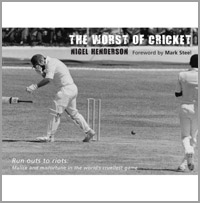We have been swallowing the myth for years; that cricket is a gentlemanly pursuit, where bad luck is something to be borne stoically, and bad behaviour is poor form that will get you drummed out of the club. This is plainly nonsense.
This book is a warts-and-all celebration of that truth: that cricket is sometimes so bad to its participants that they have no option other than to hit back just as hard. So pad up and take your guard for a full panoply of cricket horror stories: from the worst umpiring decisions, the worst tantrums and the worst injuries to the worst riots, worst gamesmanship and worst dismissals; from the worst confrontations and the worst upsets to the worst mistakes and worst off-field misdemeanours... all from the first-class game.
The Worst of Cricket has eleven chapters, the worst umpiring decisions, the worst tantrums, the worst confrontations, the worst mistakes, the worst riots and crowd disturbances, the worst upsets, the worst injuries, the worst gamesmnship, the worst dismissals, the worst off pitch crimes and misdemeanours and the best of the rest of the worsts.
The Worst of Cricket 2 covers More of the worst Umpiring decisions, the worst collapses, more of the worst injuries, the worst fielding, more of the worst dismissals, the worst run-outs, more of the worst tantrums, more of the worst mistakes, more of the worst confrontations, more of the worst off-field crimes and misdemeanours and the best of the rest of the worst.
In More of the worst umpiring decisions, the author has mentioned the case of Asad Rauf & Billy Doctrove (West Indies vs. India - second one-day international, Kingston, Jamaica, May 2006). "Umpires have enough to worry about on the field without having to take peripheral matters into consideration. Ask Dickie Bird, who once had to halt play and signal to Old Trafford corporate spongers to shut a window that was deflecting sunlight straight into a batsman's eyes Or ask Billy Doctrove, who found himself implicated in one of the most embarrassing moments to be captured by the television cameras.
Ramnaresh Sarwan, batting with Brian Lara, dropped the first ball of an over down on the leg-side and looked a little surprised to be called through by his captain for a single. Suresh Raina spotted his chance for glory and raced in from mid-wicket, throwing down the stumps as Lara strained to make the crease. Mahendra Singh Dhoni, the wicketkeeper, Raina and Virender Sehwag all turned and appealed to the square leg umpire - only to find that there was no square leg umpire: no Billy Doctrove.
When he was finally located, it was in front of the sightscreen on the boundary edge. He had nipped off between overs to deal with some spectators who had taken up residence behind the bowler's arm and Asad Rauf, at the other end, had allowed the next over to start without noticing he had not returned. Fortunately, slow-motion replays indicated that Lara had made his ground comfortably and the umpires sought to ease their shame by declaring it a dead ball."
Jesse Ryder figures in a chapter More of the Worst off-field crimes and misdemeanours. "When at 5.30 in the morning after the night before, having chased down several pints with a few tequila slammers in the Stock X Change bar in Christchurch in celebration of his part in the one-day series victory over England, New Zealand opener Jesse Ryder found himslf desperately in need of the lavatory, it is hardly surprising that he reacted to the frustration of discovering it locked with the same brutal simplicity that he had shown to demoralise the touring team's bowlers.
Instinctively, he thrust his right hand through a glass partition, lifted the lock off its latch and went about his by now imminent business. It was only then that he noticed he had done some serious damage to his hand, so he set off on foot to casualty at a nearby hospital, where he compounded his problems by insulting staff, who he felt were too slow in seeing to him. 'Don't you know who I am?' he proclaimed rather haughtily."
Both the volumes of The Worst of Cricket are a worthy tribute to the many people who have made all this possible. Attractively laid out, logically organised and lucidly written, the books are recommended reading.
|

